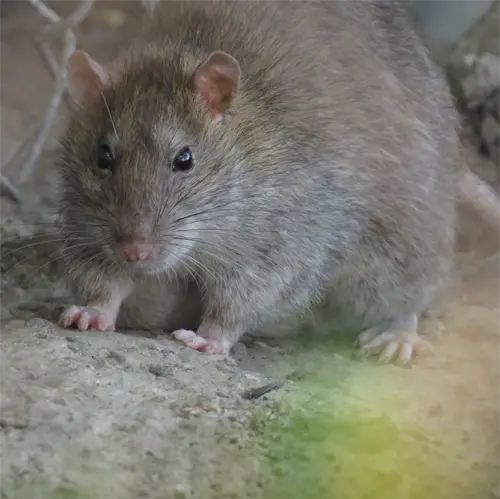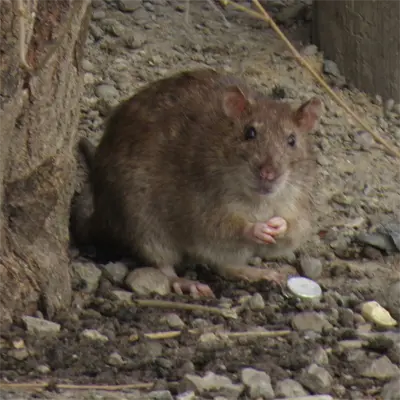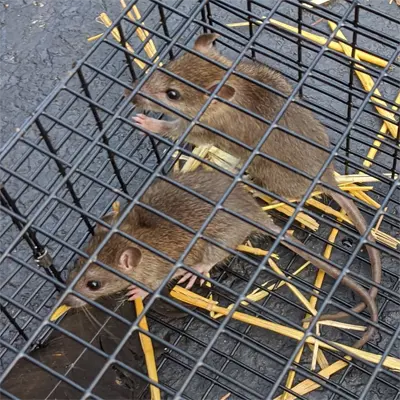Brown Rats in Central Florida
The brown rat (Rattus norvegicus) is a large, burrowing rodent that thrives in urban environments like central Florida. Often confused with the roof rat (Rattus rattus), brown rats are distinguished by their stockier build, smaller ears, shorter tail, and less adept climbing ability.
As their name suggests, brown rats construct underground burrow systems and nest at ground level in basements and sewers.
This comprehensive guide provides detailed identification tips, biology facts, and prevention and control methods for brown rats in central Florida.
Read on to learn brown rat habits, reproduction, diet, health risks, signs of infestation, and professional treatment options if you suspect an infestation on your property.
Appearance and Identification
Brown rats can be distinguished from roof rats and house mice by their physical characteristics at both juvenile and adult stages
Roof rats tend to have finer features with larger ears, pointed rostrum, longer cauda, and narrower feet better suited for climbing. Brown rats are less agile climbers compared to roof rats and house mice due to stockier anatomical features. Identifying characteristic signs like tracks, feces, burrows, and nests also aids in detection.
Maturation Rate
Young brown rats grow rapidly, reaching reproductive maturity in 3 to 4 months after birth. They are independent within a month and reach adult size by 3 months old. The average lifespan of brown rats is about 1 year. Their high fecundity allows brown rat infestations to quickly rebound after elimination efforts.
Habits and Behavior
Brown rats are nocturnal and most active during crepuscular periods at dawn and dusk. They prefer living at ground level in burrow systems. Brown rats are capable diggers and can excavate extensive tunnels leading to nest chambers. Inside structures, brown rats stay at ground level in basements, crawlspaces, and sewers.
Outdoors, brown rats dig branching burrow systems with multiple entrances and nesting chambers. They only climb when necessary. Brown rats tend to be social and live in small colonies with complex social structures.
Reproduction and Lifespan
Brown rats have a high reproductive capacity. Females can start breeding as early as 2 to 3 months old. They produce up to 7 litters per year with 6 to 12 young per litter. The gestation period ranges from 21 to 26 days.
Ideal Habitat and Range
Central Florida’s warm, humid subtropical climate provides prime habitat for brown rats year-round. Average temperatures range from the low 70sF (22C) in the north to upper 70sF (25C) in the south, with summer highs in the 90sF (30sC). Annual rainfall exceeds 50 inches (1270 mm) especially during the summer rainy season.
The combination of warmth and moisture allows dense vegetation, crops, and refuse to accumulate. Rural wetlands, forests, farms, landfills, and sewers surround urban centers, harboring large brown rat populations. Developed areas offer garbage and food waste. Brown rats inhabit burrows, sewers, basements, and ground floors. Older buildings provide entry through cracks and faulty plumbing.
As prolific breeders, brown rat numbers multiply rapidly given central Florida’s ideal climate, shelter, and food availability. Diligent exclusion, sanitation, and population control is required to prevent destructive infestations due to the region’s prime conditions.
Diet and Feeding
Brown rats are omnivores and consume a wide variety of foods. They require about 1 oz of food and 1 oz of water daily. Brown rats don’t need to drink water if they have access to moist foods. Brown rats are omnivores that eat a diverse range of food types.
Their diet includes Grains – wheat, corn, rice, oats, Fruits – citrus, melons, berries, Garden vegetables, Nuts and seeds, Pet food, Fish and meat scraps, Insects – roaches, beetles, Eggs and young birds.
Brown rats forage for food at night and will travel 100 ft (30 m) or more from their nest to find sources. They leave odor trails which other rats follow.


Common Health Risks
Brown rats can transmit a concerning number of zoonotic diseases to humans directly and through fleas, mites, and ticks:
- Leptospirosis – Spread through urine on surfaces. Causes fever, chills, vomiting.
- Salmonellosis – Spread through feces on surfaces. Causes diarrhea, fever, cramps.
- Rat bite fever – Spread by infected rat saliva from bites. Causes muscle pain, fever, headache.
- Hantavirus – Spread by deer mice but brown rats can carry. Often fatal pulmonary disease.
- Rickettsial diseases – Spread by infected rat fleas. Includes typhus, spotted fever.
- Plague – Caused by Yersinia pestis bacteria and spread by infected rat fleas. Can be fatal if untreated.
Brown rats also trigger asthma symptoms in sensitive individuals due to buildup of urine, dander, and debris in infested areas. Prompt treatment of brown rat infestations through exclusion, sanitation, and population control is crucial to avoid health risks.

Preventing Brown Rat Infestations
The key is to deny brown rats access into structures by sealing all possible entry points.
Eliminate clutter and trim vegetation touching buildings. Seal openings wider than 1/2 inch (12 mm) with concrete, wire mesh, or metal sheeting.
Traps and rodenticides can also be used to remove existing populations if infested. Prevent access to garbage and food waste.
Population Control Methods
If exclusion alone is insufficient to prevent Florida water rat damage, lethal control using traps or rodenticides may be considered. Traps such as snap traps, cage traps, or body-grip traps can humanely capture rats for relocation or euthanasia. Glue boards are another trapping option.
Poison baits are also effective but must be used cautiously around waterways. Zinc phosphide baits are commonly used though anticoagulant baits are safer for wildlife. Control is most effective when animals are active in spring through fall – winter trapping is less productive.
Always follow label directions carefully when utilizing any rodenticides.
Brown Rats in Central Florida – Conclusion
Brown rats are tenacious, destructive pests that require vigilant management in central Florida’s urban environments.
However, through proactive inspection, exclusion, sanitation, trapping, and population control, brown rat invasions into homes can be prevented.
Signs like rub marks, gnawing, feces, burrows, and noises behind walls point to the need for professional rat control services. With early intervention and an integrated pest management approach focused on exclusion, brown rats can be eradicated and re-infestation avoided.







